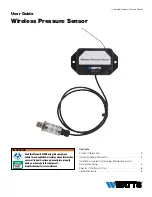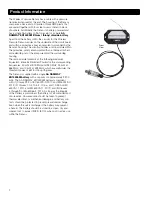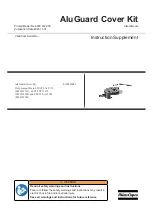
4
Installation, Operation, Servicing, Maintenance, and Decommissioning
WARNING
!
The Wireless Pressure Sensor must be installed, operated, serviced, maintained, and decommissioned in accordance with the
following standards, instructions, and requirements .
1 . The Wireless Pressure Sensormust be installed, operated, serviced, maintained, and decommissioned in accordance
with relevant laws, regulations, and other rules promulgated by any legal authorities with jurisdiction where the Wireless
Pressure Sensor is to be installed, operated, serviced, maintained, and decommissioned .
2 . The Wireless Pressure Sensor must be installed, operated, serviced, maintained, and decommissioned in accordance with
ALL instructions, guidance, conditions, and requirements appearing in these safety instructions herein below .
In determining a surface to which to affix the Sensor, consider again that the Sensor did not go through an impact test . DO NOT
affix the Wireless Pressure Sensor higher than two meters above a surface it would strike in the event of a fall . DO NOT affix the
Wireless Pressure Sensor where it is likely to be bumped by personnel . DO NOT affix the Sensor anywhere where moving parts
of machinery may strike it .
The Wireless Pressure Sensor MUST be installed in a location where it will be protected and sheltered from ALL sunlight and
other luminaries emitting light at UV wavelengths . Additionally, the housing of the Wireless Pressure Sensor is made of ABS
plastic with two nylon adhesive labels adhering to it, which may present a potential for electrostatic discharge . Do NOT affix the
Sensor anywhere where personnel are likely to rub against it . Also, the Wireless Pressure Sensor MUST be installed 1,000 mm
distance from a potential electrostatic source, such as a conveyor belt, moving machinery, pipe, or the like .
WARNING
!
The Wireless Pressure Sensor must only be installed, operated, serviced, maintained, and decommissioned by qualified
personnel . All qualified personnel involved in the aforementioned activities must meet the following requirements .
1 . All qualified personnel involved in any of the foregoing activities must first familiarize themselves with the Wireless Pressure
Sensor, its functionality, and components before attempting to engage in any such activities .
2 . All qualified personnel must be familiar with and adhere to the relevant laws, regulations, and or other rules promulgated by
any legal authorities with jurisdiction where the Wireless Pressure Sensor is to be installed, operated, serviced, maintained,
and decommissioned .
WARNING
!
Use Only Ramway ER14505M Batteries
A single
AA RAMWAY ER14505M lithium / thionyl chloride battery
is the ONLY battery that can be used with the Wireless
Pressure Sensor . Any other battery, or combinations of batteries, may result in a thermal ignition or a spark ignition event causing
an explosion .
WARNING
!
Do Not Replace the Battery When an Explosive Atmosphere Is Present
The Wireless Pressure Sensor
MUST NOT be opened
and the single
AA RAMWAY ER14505M lithium / thionyl chloride
battery MUST NOT be removed, reinserted or replaced
when an explosive atmosphere, comprised of either gas or
dust, is either present or potentially present . Qualified personnel MUST EITHER remove the Sensor from a hazardous location
where an explosive atmosphere is either present or potentially present, OR the qualified personnel MUST clear the area where
the Wireless Pressure Sensor is located of any explosive atmosphere and ensure its absence .
Installation and Setup
To install the Wireless Pressure Sensor, slide the face top of the Sensor around the axis of the single screw holding the top lid in
place to expose the single AA battery coffin within the housing . Remove the battery notice sticker, making sure to take note of
the information thereon . Insert the
RAMWAY ER14505M battery
, provided with the Sensor, in the battery coffin . Make sure that
the battery is inserted with the correct polarity as identified by the molded symbol in the battery coffin . A single
AA RAMWAY
ER14505M lithium / thionyl chloride battery
MUST be used and ONLY the RAMWAY ER14505 battery . Additionally,
take
note of the Sensor ID and security code
before closing up the unit . They will be needed to network the device later, as set
forth in the User Guide . Slide back the face top so that it covers the cavity of the housing and screw the remaining three black
screws in place with a standard screw driver .


























